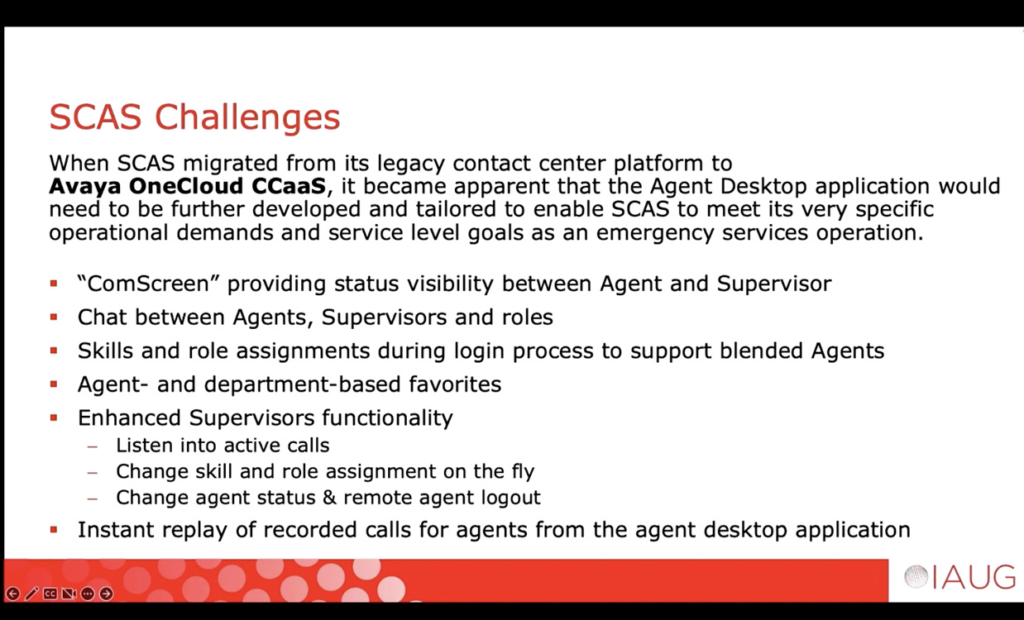When a UK regional ambulance service migrated from its legacy contact center platform to Avaya OneCloudTM CCaaS, it became clear that Avaya’s Agent Desktop application needed to be customized for its specific requirements.
Chris Hayden, telephony manager, South Central Ambulance Service (SCAS), part of the UK’s National Health Service Foundation Trust, outlined the collaborative process in an IAUG Wired presentation, “Development of a Tailored CCaaS for South Central Ambulance Service.” The conversational session with Dirk Engelbart, founder, and CEO, Engelbart Software GmbH; and Markus Bornheim, international practice lead, public safety and emergency, Avaya; provided a case study of how to leverage the Avaya Experience Builders™ ecosystem.
“We needed a tailored solution to meet our very specific operational demands and service level goals as an emergency services operation,” said Hayden adding that SCAS serves about 3.3 million people in England with emergency and nonurgent care, as well as workstreams around mental health, social services, and midwifery. To support patients and families, SCAS has a single virtual contact center across six locations staffed by 200 to 300 agents.
“The tools you get out of the box didn’t quite meet the requirements of our customer base,” said Hayden, who turned to Englebart Software to develop special purpose APIs that could be integrated within the Avaya solution.

Adding supervisor functions
For SCAS, the key customization involved elevating the supervisor tool with additional functionality to ease interactions with agents, including:
• Listening to active calls. “We have clinical staff listening to live calls who can intervene if they can offer a better care pathway to the caller,” Hayden said. “That also helps ensure the right resources are sent, such as a rapid response versus an emergency service.”
• Changing agent skill assignments. “As a multilocation center, the ability to change skills with hundreds of agents can be challenging,” said Hayden. “An agent might be a call taker one day, a dispatcher or a team leader on other days.” Now, a supervisor can do that on the fly rather than having to into Communications Manager, change the skill and log in and out. If there is a spike in demand on the real-time display, an agent’s role can be changed or blended seamlessly.
• Changing agent status. SCAS supervisors may be in charge of agents in multiple geographic locations, so the ability to change status remotely is a significant benefit, Hayden said. “It allows a manager to put an agent on break in a not-ready state, for example.”
• Adding remote agent logout. If an agent finishes a shift but forgets to log out, the supervisor can take care of that oversight.
Looking ahead
SCAS is now looking at moving forward with Engelbart Software on additional CCaaS functionality. “We want to move our system up a notch in order to better serve our customers and support our agents,” Hayden said.
Those planned enhancements include:
• Virtual “raise your hand” ability so agents can request supervisor support when working from home.
• Last agent routing so new calls can be forwarded directly to the last engaged agent.
• Missed calls queue that displays missed calls with a callback function.
• Call back option for callers who don’t want to wait on hold.
• Call deflection, voice FAQ and conversational AI for automated call answering.
• Voice transcription and translation services for turning speech into text and handling calls in various languages.
• Omni channel integration with email, SMS and social media.
As Englebart said, “This type of close relationship is what the Avaya Experience is all about – building direct relationships with development teams that understand an organization’s unique business requirements.”
